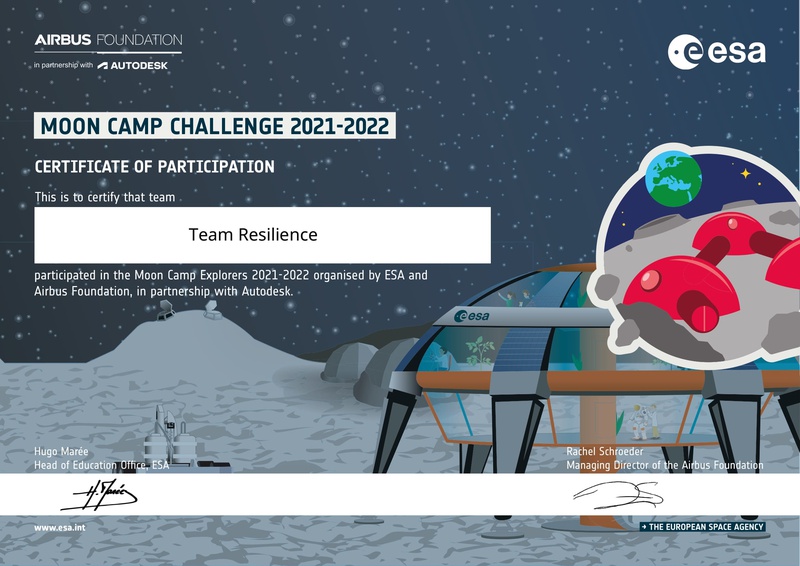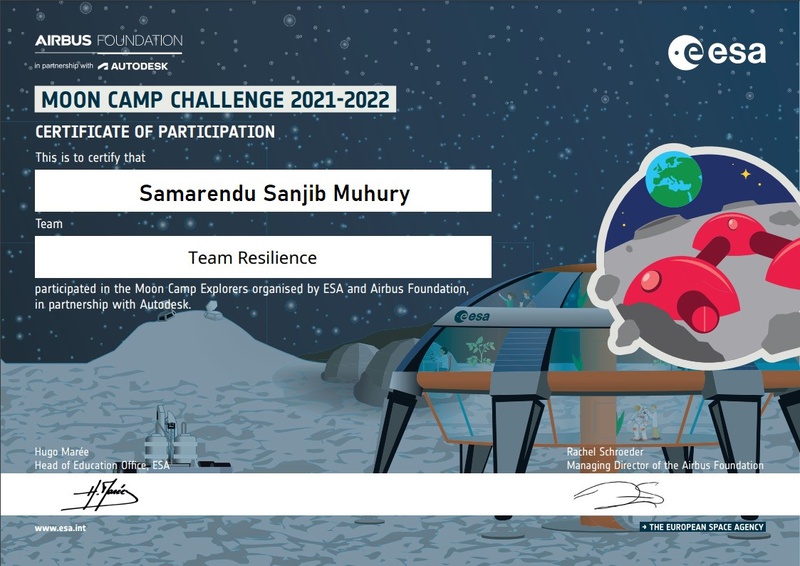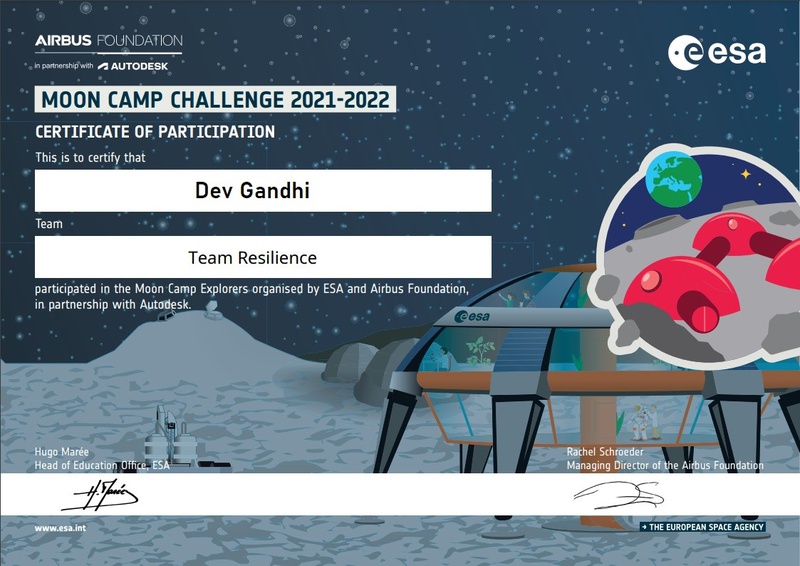Team Resiliance's lunar base Project
About project:
Our team name is “Team Resilience” because humans have landed on the Moon many times, but have never made a base there whereas; Team Resilience will strive to this goal to show the resilience of the Homo-sapiens. There will be 11 astronauts per stay, and a term will last 6 months. We will experiment on survivability, resources, botany, exploration, geography, zoology, biology, physics, technology, and storage. Our camp will have general rooms, cabins, airlocks, labs, storage, resource collection, etc. The uniqueness in our camp comes in both arrangement and technique. All rooms with sloped or curved roofs are on the lunar surface, whilst flat-roofed ones will be above ground. Some of the experiments we will be conducting are:
Where do you want to build your Moon Camp?
Oceanus Procellarum
Why did you choose this location?
The Oceanus Procellarum has adaptable temperatures as it is in the Moon’s ‘temperate zone’. We get adequate amounts of day and night, thus ensuring enough sunlight and sleep! We have easy access to ice deposits in the North Pole of the Moon, giving us enough water and helping us learn how to store the water. We get many silicate materials in the Moon’s Northern Temperate Zone, allowing for easy access to minerals. The Oceanus Procellarum is relatively flat, and is perfect for building a base that is both underground and above ground.
How do you plan to build your Mooncamp? Which materials will you use?
Astronauts will employ the use of robots to build bigger structures, and small parts will be 3D printed. The solar panels, antennae, and all other technical equipment will be brought from Earth, whilst the rooms, walls, etc. will be built from raw materials supplied from Earth. Stainless steel, carbon fiber, titanium, graphene, and small amounts of gold will be used for construction.
How do you plan to provide the astronauts with the follwoing things?
Water
We will initially transport water from Earth until the purification plant can be made. We will be taking ice back in special freezers, then mining it in the base, then purifying it using the ‘aqua factorem’ process. This involves sieving the water. We will be using a double-filter aqua-factorem sieve.
Food
We will be using seed film to grow our plants. We will be planting potatoes to make baked potatoes and tomatoes for a Vitamin C and D boost! We have 2 greenhouses, and it will be monitored by 1 astronaut. The seed film technique will use ‘plant pillows’ to grow plants which will use injected nourishments like water.
Electricity
We will be using photovoltaic energy, as it is a stable source of energy. The photovoltaic fields will be located on the edge of Oceanus Procellarum. We will have an electricity storage facility located directly below our photovoltaic fields, which can store up to 100 kW of electricity. The batteries are multiple car batteries.
Air
We will get both N2 and CO2 from Earth and will use the water electrolysis method to get O2. For N2, in later phases, it will be collected from dying plants in the greenhouses. In the electrolysis method, the hydrogen and oxygen found in water is separated by positive and negative charges in which the oxygen is attracted to the negative while the hydrogen is to the positive. We can then utilize the oxygen. When a plant dies, the nitrogen it adds to the soil is then extracted and used.
Protection
We use a graphene-like material to coat all the buildings above-ground. All underground buildings will be made of stainless-steel. For protection from meteorites, we use a unique system that is above our base, it is a set of sliding doors made of quadruple-layer graphene. The doors close when there is a warning about a meteor shower or radiation event, thus protecting the base. For protection from radiation, we have buildings which, as mentioned before, are made of graphene.
Describe a day on the Moon for one of your Moon Camp astronauts
We will follow the GMT (Greenwich Mean Time) time zone. They will wake up at 8:00 AM. They will then follow any human’s normal daily routine. However, after breakfast, they will work on individual roles such as experimenting, moonwalking, etc. until 1 PM, when they have lunch. After lunch, they all are allowed to go to the bar for a quick drink, and then it’s back to work until 7:30 PM, when they have dinner. They then all go to the communications room to tell Earth how their day went. They all go to sleep at 9:30 PM. We will have scientists, technicians, etc. Our astronauts have access to the high-tech ‘AAPS Space-suit’, they travel from one-place to another by walking and using the rovers. They have access to a bar, computer lab, theatre, etc.


About Team:
I am Samarendu Sanjib Muhury
I am Dev Gandhi
Our team name is “Team Resilience” because humans have landed on the Moon many times, but have never made a base there whereas; Team Resilience will strive to this goal to show the resilience of the Homo-sapiens. There will be 11 astronauts per stay, and a term will last 6 months. We will experiment on survivability, resources, botany, exploration, geography, zoology, biology, physics, technology, and storage. Our camp will have general rooms, cabins, airlocks, labs, storage, resource collection, etc. The uniqueness in our camp comes in both arrangement and technique. All rooms with sloped or curved roofs are on the lunar surface, whilst flat-roofed ones will be above ground. Some of the experiments we will be conducting are:
- Testing whether the moon is hospitable for future settlement (survivability)
- Searching for new resources (resources)
- Testing whether the moon can support plant life (botany)
- Searching and storing of water (exploration)
- Mapping the moon accurately (geography)
- Can animals be bred on the moon? (zoology)
- Can the human body survive long-term on the moon? (biology)
- How will we eat in space? (survivability)
- Do general laws of physics apply in space (physics)
- New technological advancements (technology)
- Experiments on how to eat and drink (survivability)
- Our camp is different from others as we have chosen a location on the Moon which nobody else has selected. Our camp has 4 levels, including the drainage system.
Where do you want to build your Moon Camp?
Oceanus Procellarum
Why did you choose this location?
The Oceanus Procellarum has adaptable temperatures as it is in the Moon’s ‘temperate zone’. We get adequate amounts of day and night, thus ensuring enough sunlight and sleep! We have easy access to ice deposits in the North Pole of the Moon, giving us enough water and helping us learn how to store the water. We get many silicate materials in the Moon’s Northern Temperate Zone, allowing for easy access to minerals. The Oceanus Procellarum is relatively flat, and is perfect for building a base that is both underground and above ground.
How do you plan to build your Mooncamp? Which materials will you use?
Astronauts will employ the use of robots to build bigger structures, and small parts will be 3D printed. The solar panels, antennae, and all other technical equipment will be brought from Earth, whilst the rooms, walls, etc. will be built from raw materials supplied from Earth. Stainless steel, carbon fiber, titanium, graphene, and small amounts of gold will be used for construction.
How do you plan to provide the astronauts with the follwoing things?
Water
We will initially transport water from Earth until the purification plant can be made. We will be taking ice back in special freezers, then mining it in the base, then purifying it using the ‘aqua factorem’ process. This involves sieving the water. We will be using a double-filter aqua-factorem sieve.
Food
We will be using seed film to grow our plants. We will be planting potatoes to make baked potatoes and tomatoes for a Vitamin C and D boost! We have 2 greenhouses, and it will be monitored by 1 astronaut. The seed film technique will use ‘plant pillows’ to grow plants which will use injected nourishments like water.
Electricity
We will be using photovoltaic energy, as it is a stable source of energy. The photovoltaic fields will be located on the edge of Oceanus Procellarum. We will have an electricity storage facility located directly below our photovoltaic fields, which can store up to 100 kW of electricity. The batteries are multiple car batteries.
Air
We will get both N2 and CO2 from Earth and will use the water electrolysis method to get O2. For N2, in later phases, it will be collected from dying plants in the greenhouses. In the electrolysis method, the hydrogen and oxygen found in water is separated by positive and negative charges in which the oxygen is attracted to the negative while the hydrogen is to the positive. We can then utilize the oxygen. When a plant dies, the nitrogen it adds to the soil is then extracted and used.
Protection
We use a graphene-like material to coat all the buildings above-ground. All underground buildings will be made of stainless-steel. For protection from meteorites, we use a unique system that is above our base, it is a set of sliding doors made of quadruple-layer graphene. The doors close when there is a warning about a meteor shower or radiation event, thus protecting the base. For protection from radiation, we have buildings which, as mentioned before, are made of graphene.
Describe a day on the Moon for one of your Moon Camp astronauts
We will follow the GMT (Greenwich Mean Time) time zone. They will wake up at 8:00 AM. They will then follow any human’s normal daily routine. However, after breakfast, they will work on individual roles such as experimenting, moonwalking, etc. until 1 PM, when they have lunch. After lunch, they all are allowed to go to the bar for a quick drink, and then it’s back to work until 7:30 PM, when they have dinner. They then all go to the communications room to tell Earth how their day went. They all go to sleep at 9:30 PM. We will have scientists, technicians, etc. Our astronauts have access to the high-tech ‘AAPS Space-suit’, they travel from one-place to another by walking and using the rovers. They have access to a bar, computer lab, theatre, etc.


Name: Samarendu Sanjib Muhury
Age: 9

Name: Dev Gandhi
Age: 10
